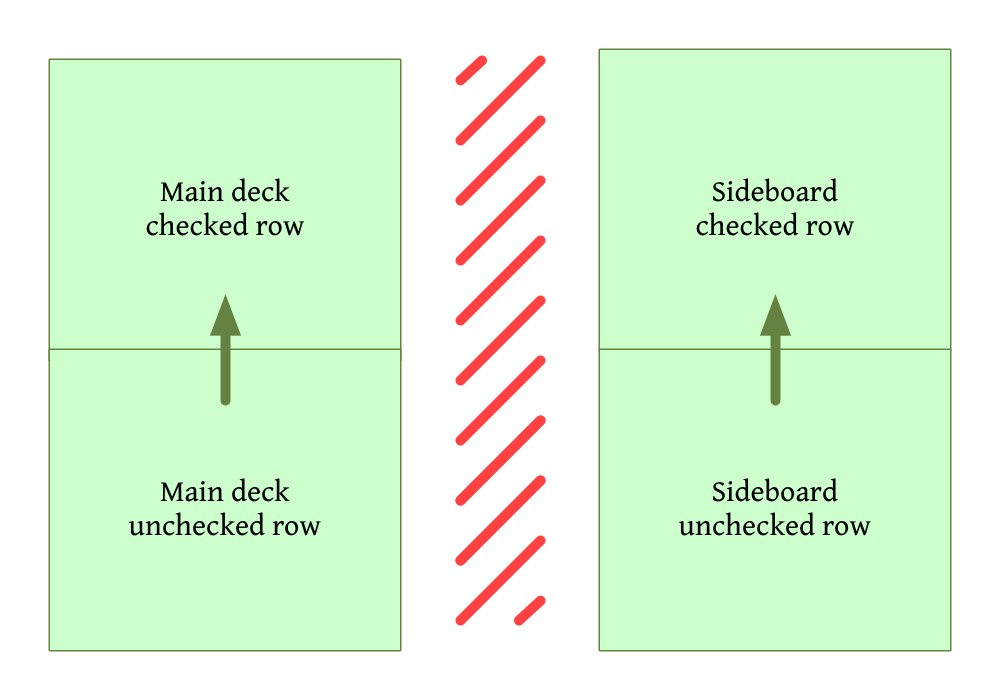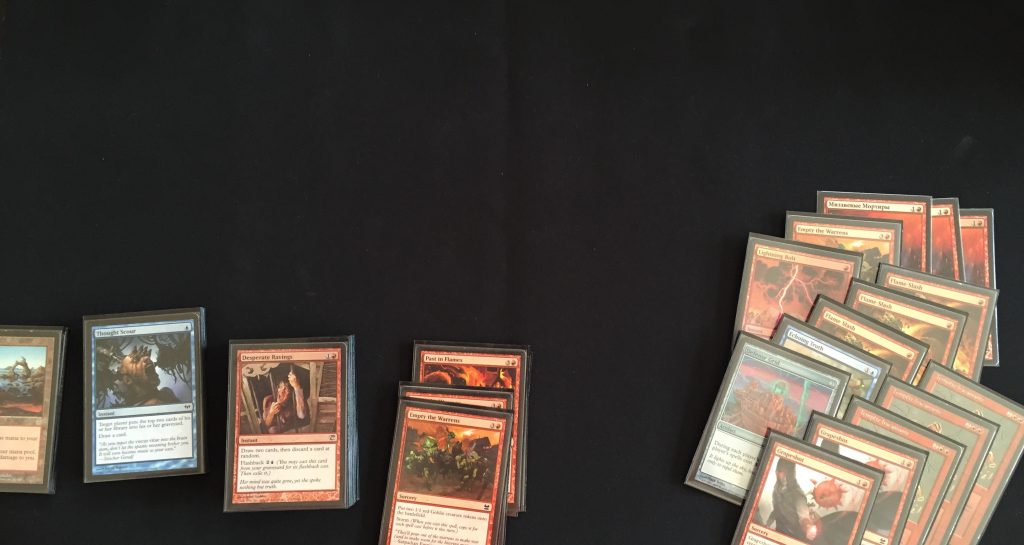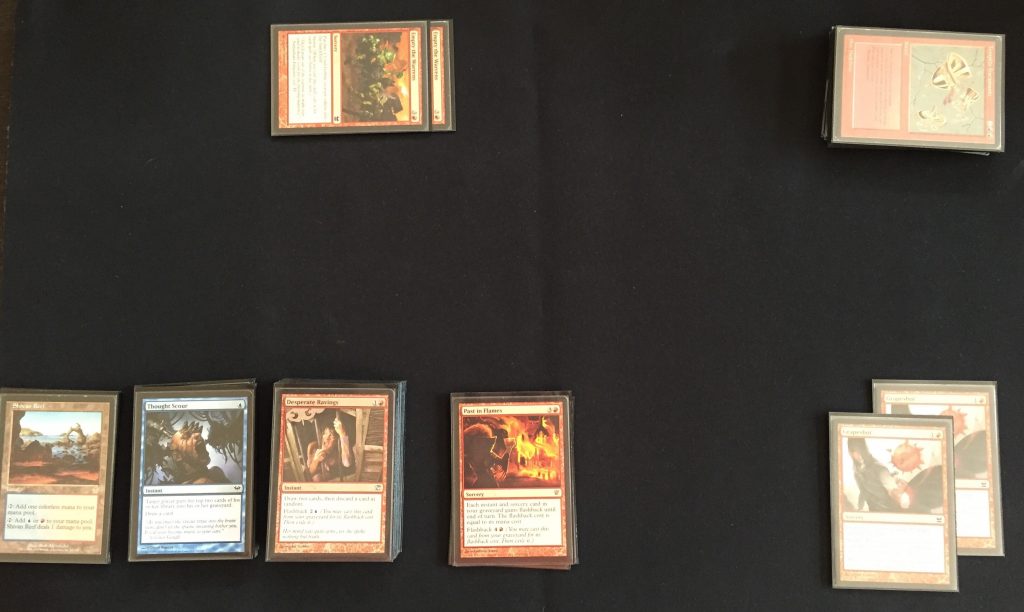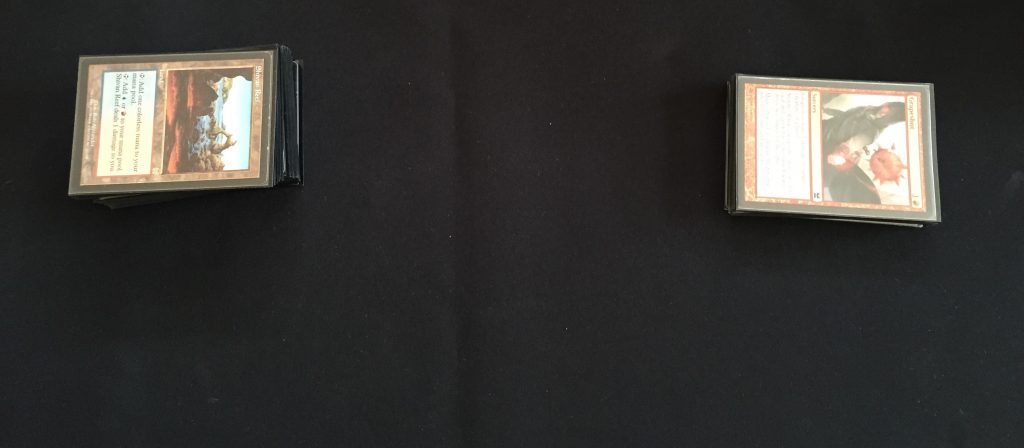Note that for midround Limited deck checks try the “Australian Deck Check” technique instead, designed specifically for those!
Preliminary operations
Once you have the decks back to the deck check area:
- Check for any markings or damaged sleeves in the main deck.
It’s only an infraction if the cards in the main deck are marked, but if you notice markings on the sideboard, it’s good customer service to tell the player so they avoid future problems. - Sort the main deck.
I recommend sorting Constructed decks by Converted Mana Cost, and grouping anything CMC 6+ together. You can sort however is fastest and easiest for you. - Fan out the sideboard.
So you can see all the cards there at once.
The “Lanes” system
From here there’s two “lanes”, one for the deck, and one for the sideboard.
Cards can only go forward in their lane, from the unchecked row to the checked row, and most importantly, cards can never change lanes.
If you change the lane of a card that would mean we are changing the sideboarding choices of the player.
The main deck sorted by CMC, and the sideboard laid out, ready to start
1) Check the sideboard
As with start of round deck deck checks, start by going through the cards listed as the sideboard on the decklist, and making sure all the cards are there.
We check the sideboard first as it’s the most likely place for there to be a problem, and if there is a problem we want to start dealing with it as soon as possible. If you only find the problem as you finish the deck check then you might have a long time extension, so start looking where they’re most likely.
Read through the cards listed in the sideboard on the decklist, for each card:
- Pull that card out of the unchecked sideboard and move it away from you, forwards in its lane, to the checked sideboard pile.
- If there’s a card you can’t find in the unchecked sideboard it means the player sideboarded it into their deck this game. Put down any sideboard cards you’re holding so they don’t cross lanes, then find the card in the main deck and move it forwards in its lane, from the unchecked main deck to the checked main deck.
- Again, no card can ever change lanes. Make sure there’s plenty of space between the two lanes, to make it hard to accidentally move cards between lanes.
When you move a card forward to the checked row, it helps to also “tap” them, to make it clear they have been checked.
The sideboard has been checked, all 15 cards from it have been moved up to “checked”
2) Check the main deck.
Now that all the cards listed on the sideboard have been moved, the cards left over in the two lanes should match the main deck on the decklist.
Like before, read through the cards listed on the main deck, and for each card in order move it forwards in its lane.
Be careful with any cards where a player has sideboarded out some copies, but not all of them.
If they have 4 Lightning Bolt listed on their decklist, and there are 2 in their main deck and 2 in the sideboard when you check the deck, move the cards forwards in each lane when you count them, don’t combine them!
3) Deal with any problems, and return the deck.
- If there’s anything left over it wasn’t listed on the decklist OR;
- If there’s anything written on the decklist that you can’t find, it wasn’t with the cards the player presented.
There is a problem! Investigate, including making sure it was not a mistake by you, and fix them!
When returning the deck to players make sure there’s a physical divider between the main deck and sideboard, a divider they had in their deckbox, the match slip, or even just a small piece of paper. This prevents the cards being mixed up as the player takes them back from us.
There was nothing left over, and nothing that we couldn’t find on the list, return the deck!
Feedback, suggestions, and questions are all welcome! Let us know what works best for you, it might help others too.
Fabian Peck




